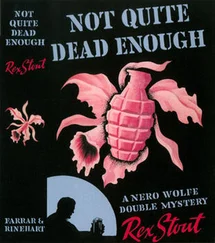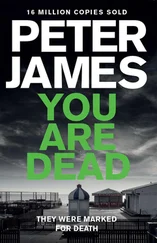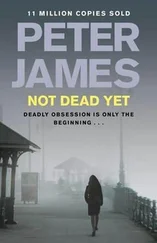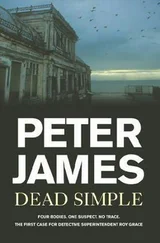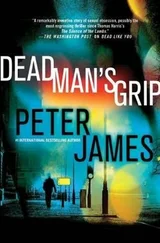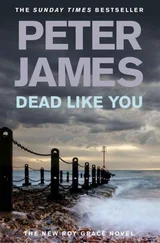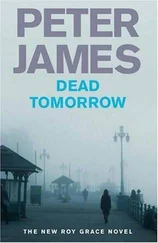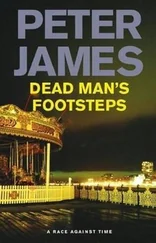Peter James - Not Dead Enough
Здесь есть возможность читать онлайн «Peter James - Not Dead Enough» весь текст электронной книги совершенно бесплатно (целиком полную версию без сокращений). В некоторых случаях можно слушать аудио, скачать через торрент в формате fb2 и присутствует краткое содержание. Жанр: Старинная литература, на английском языке. Описание произведения, (предисловие) а так же отзывы посетителей доступны на портале библиотеки ЛибКат.
- Название:Not Dead Enough
- Автор:
- Жанр:
- Год:неизвестен
- ISBN:нет данных
- Рейтинг книги:5 / 5. Голосов: 1
-
Избранное:Добавить в избранное
- Отзывы:
-
Ваша оценка:
- 100
- 1
- 2
- 3
- 4
- 5
Not Dead Enough: краткое содержание, описание и аннотация
Предлагаем к чтению аннотацию, описание, краткое содержание или предисловие (зависит от того, что написал сам автор книги «Not Dead Enough»). Если вы не нашли необходимую информацию о книге — напишите в комментариях, мы постараемся отыскать её.
Not Dead Enough — читать онлайн бесплатно полную книгу (весь текст) целиком
Ниже представлен текст книги, разбитый по страницам. Система сохранения места последней прочитанной страницы, позволяет с удобством читать онлайн бесплатно книгу «Not Dead Enough», без необходимости каждый раз заново искать на чём Вы остановились. Поставьте закладку, и сможете в любой момент перейти на страницу, на которой закончили чтение.
Интервал:
Закладка:
Like an operating theatre, the room contained nothing that served any decorative purpose, nothing superfluous or frivolous, nothing to relieve the grimness of the work that took place in it. But at least in an operating theatre, people were driven by hope. In this room there was no hope, just clinical curiosity. A job that had to be done. The soulless machinery of the law at work.
The moment you died, you ceased to belong to your spouse, your partner, your parents, your siblings. You lost all your rights and became the custodial property of your local coroner, until he, or she, was satisfied that it was really you that was dead and that it was clear what had killed you. It didn’t matter that your loved one didn’t want your body eviscerated. It didn’t matter that your family might have to wait weeks, sometimes months before burying or cremating you. You were no longer you . You were a biology specimen. A mass of decomposing fluids, proteins, cells, fibres and tissues, any microscopic fragment of which might or might not have a story to tell about your death.
Despite his revulsion, Grace was fascinated. He always had to watch their seemingly tireless professionalism, and he was in awe of the painstaking care which these Home Office pathologists took. It wasn’t just the cause of death that would be established for certain on this slab; there were countless other clues the body might yield, such as the approximate time of death, the stomach contents, whether there had been a fight, sexual assault, rape. And with luck, perhaps in a scratch or in semen, the current holy grail of clues, the murderer’s DNA. Often, today, the post-mortem was really the place where a crime got solved.
Which was why Grace, as Senior Investigating Officer, had to be present, accompanied by another officer – Glenn Branson – in case for any reason he had to leave. Derek Gavin from the SOCO team was also there, recording every stage on camera, as well as the coroner’s officer, a grey-haired former policewoman in her mid-forties, so quiet and unobtrusive she almost blended into the background. Also present were Cleo Morey and her colleague Darren, the Assistant Anatomical Pathology Technician, a sharp, good-looking young man of twenty, with spiky black hair, who had started life appropriately enough, Grace thought, as a butcher’s apprentice.
Nadiuska De Sancha, the pathologist, and the two technicians wore heavy-duty green aprons over green pyjamas, rubber gloves and white gumboots. The rest of the people in the room were in protective green gowns and overshoes. Katie Bishop’s body was wrapped in white plastic sheeting, with a plastic bag secured by elastic bands over her hands and feet, to protect any evidence that might be trapped under her nails. At the moment, the pathologist was unwrapping the sheeting, scrutinizing it for any hairs, fibres, skin cells or any other matter, however small, that might turn out to have belonged to her assailant, which she might have missed when examining Katie’s body in her bedroom.
Then she turned away to dictate into her machine. Twenty years or so older than Cleo, Nadiuska was, in her own way, an equally striking-looking woman. Handsome and dignified, she had high cheekbones, clear green eyes that could be deadly serious one moment and sparkling with humour the next, beneath fiery red hair, at this moment pinned up neatly. She had an aristocratic bearing, befitting someone who was, reputedly, the daughter of a Russian duke, and wore a pair of small, heavy-rimmed glasses of the kind favoured by media intellectuals. She put the dictating machine back down near the sink and returned to the corpse, slowly unbagging Katie’s right hand.
When Katie’s body was, finally, completely naked, and she had taken and logged scrapings from under all the nails, Nadiuska turned her attention to the marks on the dead woman’s neck. After some minutes of examining them with a magnifying glass, she then studied her eyes before addressing Grace.
‘Roy, this is a superficial knife wound, with a ligature mark over the same place. Take a close look at the sclera – the whites of the eyes. You’ll see the haemorrhaging.’ She spoke in a voice just slightly tinged with a guttural mid-European inflection.
The Detective Superintendent, in his rustling green gown and clumsy overshoes, took a step closer to Katie Bishop and peered through the magnifying glass, first at her right eye, then at her left. Nadiuska was right. In the whites of each eye he could clearly see several bloodshot spots, each the size of a pinprick. As soon as he had seen enough he retreated a couple of paces.
Derek Gavin stepped forward and photographed each eye with a macro-lens.
‘The pressure on the veins in the neck was enough to compress them, but not the arteries,’ Nadiuska explained, more loudly now, as if for the benefit of both Roy and everyone else in the room. ‘The haemorrhaging is a good indication of strangulation or asphyxiation. What is strange is that there are no marks on her body – you would have thought if she had resisted her assailant there would be scratches or bruises, wouldn’t you? It would be normal.’
She was right. Grace had been thinking the same thing. ‘So it could be someone she knew? A sex game gone wrong?’ he asked.
‘With the knife wound?’ Glenn Branson chipped in dubiously.
‘I agree,’ Nadiuska said. ‘That doesn’t fit, necessarily.’
‘Good point,’ Grace conceded, startled at how he could have missed something so obvious – and putting it down to his tired brain.
Then the pathologist finally started the dissection. With a scalpel in one gloved hand, she lifted Katie’s tangled hair up and made an incision all the way around the back of the scalp, then peeled it forward, hair still attached, so that it hung down, inside out, over the dead woman’s face like a hideous, featureless mask. Then Darren, the assistant technician, walked across with the rotary band saw.
Grace braced himself, and caught the look in Glenn Branson’s eyes. This was one of the moments he most disliked – this and the cutting open of the stomach, which invariably released a smell that could send you retching. Darren clicked the start button and the machine whined, its sharp teeth spinning. Then that grinding sound that hit the pit of his stomach, and every nerve in his body, as the teeth tore into the top edge of Katie’s skull bone.
It was so bad, so particularly bad at this moment with his queasy stomach and pounding hangover, that Grace wanted to retreat into a corner and jam his fingers in his ears. But of course he couldn’t. He had to stick it out, as the young mortuary technician steadily worked the saw all the way round, bone fragments flying like sawdust, until finally he had finished. Then he lifted the skull cap clear, like a teapot lid, exposing the glistening brain beneath.
People always referred to it as grey matter . But to Grace, who had seen plenty, they were never actually grey – more a creamy brown colour. They turned grey later. Nadiuska stepped forward and he watched her studying the brain for some moments. Then Darren handed her a thin-bladed boning knife, a Sabatier that could have come from a kitchen cabinet. She dug inside the skull cavity, cutting the sinews and the optical nerves, then lifted the brain clear, like a trophy, and handed it to Cleo.
She carried it over to the scales, weighed it and chalked up the amount on the wall-mounted list: 1.6kg.
Nadiuska glanced at it. ‘Normal for her height, weight and age,’ she said.
Darren now placed a metal tray over Katie’s ankles, its legs standing on the table either side of her legs. Taking a long-bladed butcher’s knife, the pathologist prodded the brain in a number of places with her fingers, peering at it closely. Then, with the knife, she cut a thin slice off one end, as if she were carving a Sunday joint.
Читать дальшеИнтервал:
Закладка:
Похожие книги на «Not Dead Enough»
Представляем Вашему вниманию похожие книги на «Not Dead Enough» списком для выбора. Мы отобрали схожую по названию и смыслу литературу в надежде предоставить читателям больше вариантов отыскать новые, интересные, ещё непрочитанные произведения.
Обсуждение, отзывы о книге «Not Dead Enough» и просто собственные мнения читателей. Оставьте ваши комментарии, напишите, что Вы думаете о произведении, его смысле или главных героях. Укажите что конкретно понравилось, а что нет, и почему Вы так считаете.



